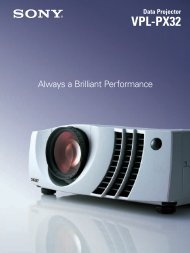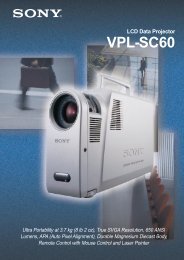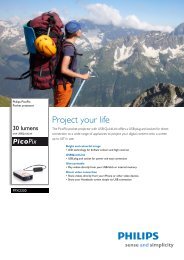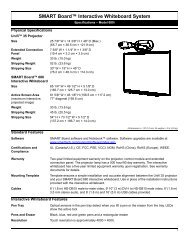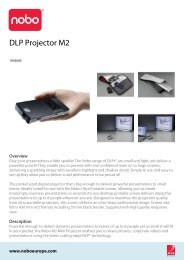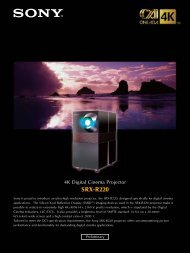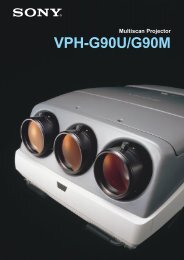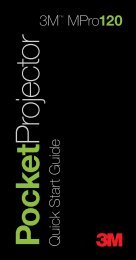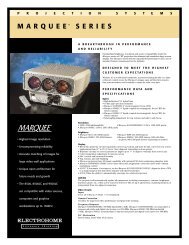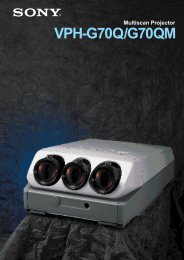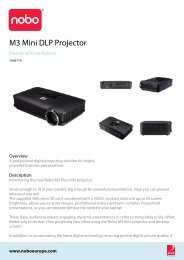DILA Tech Guide.qxd - BigScreen.se
DILA Tech Guide.qxd - BigScreen.se
DILA Tech Guide.qxd - BigScreen.se
Create successful ePaper yourself
Turn your PDF publications into a flip-book with our unique Google optimized e-Paper software.
Figure 1: Concept Diagrams and Features for Each Projection System<br />
Configuration Concept Diagram<br />
Features<br />
CRT<br />
CRT<br />
Signal input<br />
Projection lens<br />
Mature technology and low cost<br />
No p<strong>se</strong>udo-signals with no pixels<br />
Can handle specially shaped screens<br />
Resolution and light output inver<strong>se</strong>ly related<br />
Low output<br />
Large size and weight<br />
Oil film target<br />
type<br />
Lamp<br />
Vacuum chamber<br />
Spherical mirror<br />
Electron beam<br />
Oil film<br />
Light collecting lens<br />
Projection lens<br />
Mirror bar<br />
Signal input<br />
Writing and reading are <strong>se</strong>parated, so light output is higher<br />
No p<strong>se</strong>udo-signals with no pixels<br />
Can handle specially shaped screens<br />
High device costs<br />
Long startup time for vacuum device<br />
High maintenance costs<br />
Large size and weight<br />
Deterioration in S/N ratio due to film surface characteristics<br />
LCD ILA DLP<br />
Lamp<br />
Signal input LCD Projection lens<br />
Light collecting lens<br />
Polarizing plate<br />
PBS<br />
Signal input<br />
CRT<br />
Light collecting lens ILA<br />
Projection lens<br />
Lamp<br />
Light collecting lens<br />
Light collecting lens<br />
Lamp<br />
DMD<br />
Signal input<br />
Projection lens<br />
Can easily be made small and light<br />
Can be produced at low cost<br />
Easy optical configuration<br />
Resolution and light output inver<strong>se</strong>ly related<br />
Large device required for high light output<br />
Contrast limited (horizontal orientation)<br />
Provides both resolution and light output<br />
No pixels and no p<strong>se</strong>udo-signals<br />
Aperture ratio 100%<br />
High contrast<br />
Writing and reading are <strong>se</strong>parated, so high light output easily<br />
produced<br />
Can handle specially shaped screens<br />
Large size and weight<br />
Difficult to produce at low cost<br />
U<strong>se</strong>s natural light, giving it a high light efficiency ratio<br />
(in principle)<br />
High-speed respon<strong>se</strong> makes screen <strong>se</strong>quence color easy<br />
Tones managed easily with digital switching operations<br />
The device process includes mechanically moving<br />
parts and is complicated. Yields and costs are issues.<br />
The pixel pitch is restricted, so high resolutions require larger<br />
devices.<br />
The drive logic is complex.<br />
Meanwhile, following the development of conventional TVs, due to<br />
the maturity of the technology and their relatively low cost, CRT projectors<br />
had for many years dominated the projector market.<br />
However, in spite of technological advances, the<strong>se</strong> projectors<br />
remained plagued by insufficient light output and bulky, heavy<br />
designs. Eventually the CRT projection system was relegated to u<strong>se</strong><br />
in home projection TVs and specialist applications, while designs of<br />
other projectors were modified to incorporate to the newer systems.<br />
Similarly, the Eidophor and Talaria devices were pha<strong>se</strong>d out<br />
becau<strong>se</strong> the vacuum devices they required means that they were<br />
too large, heavy and expensive to compete with the newer systems.<br />
From ILA TM Projectors to D-ILA TM Projectors<br />
Around the start of the 1970s, re<strong>se</strong>arch was carried out at Hughes<br />
Aircraft into optic writing spatial modulation devices and in the<br />
1980s, projectors using this device came into practical u<strong>se</strong> (even<br />
though they were restricted to still-picture images). Continuous<br />
improvements eventually made it possible for the<strong>se</strong> devices to han-<br />
4<br />
dle moving images and by the end of the 1990s, the technology<br />
for moving images was firmly established.<br />
At the same time, JVC (Victor Company of Japan, Limited), was<br />
carrying out re<strong>se</strong>arch and development on projection methods suitable<br />
for the anticipated large-screen pictures. Determining that the<br />
optic writing spatial modulation devices were optimum for this purpo<strong>se</strong>,<br />
JVC’s R&D focu<strong>se</strong>d on practical implementation of this technology.<br />
Hughes Aircraft and JVC joined forces to develop a marketable<br />
projector and in 1993 introduced the ILA TM (Image Light<br />
Amplifier) projector. This was immediately recognized in the market<br />
as the new standard for large screen projectors in the <strong>se</strong>cond half<br />
of the 1990s.<br />
As Figure 2 shows, the ILA TM projector device is compri<strong>se</strong>d of a<br />
number of layers of 0 thin-film that are sandwiched between two<br />
glass substrates. The thin-film structure has four layers: an optoelectrical<br />
conductive layer, a light cut-off film, dielectric mirrors, and<br />
liquid crystal with ultra-fine processing to generate pixels. As<br />
Figure 1 shows, the device operates with two-dimensional CRT<br />
optical images as the writing light, forms the images in the optoelectrical<br />
conductive layer, and varies the impedance of the optic-



